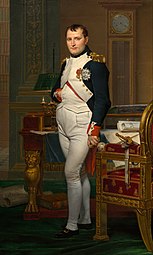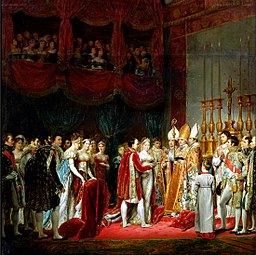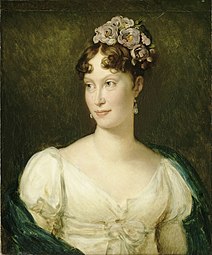Maria Luisa of Austria
Marie Louise of Austria (French: Marie-Louise d'Autriche) (Vienna, 12 December 1791 - Parma, December 17, 1847), daughter of Emperor Francis I of Austria and his wife, Princess Maria Teresa of the Two Sicilies (1772-1807).
As the eldest of the emperor's children, Maria Luisa grew up during a period of ongoing conflict between Austria and revolutionary France. A series of military defeats at the hands of Napoleon Bonaparte had inflicted a heavy human cost on Austria. The end of the Fifth Coalition war resulted in the marriage of Napoleon and Maria Luisa in 1810, which marked the beginning of a brief period of peace and friendship between Austria and the French Empire. Maria Luisa obediently accepted the marriage despite her great contempt for France. She was a dutiful and adored wife to Napoleon, eager to marry into one of Europe's leading royal houses to consolidate his relatively young empire. She gave birth to a son who briefly succeeded him as Napoleon II.
Napoleon's fortunes began to change dramatically in 1812 after his failed invasion of Russia. European powers, including Austria, resumed hostilities against France in the War of the Sixth Coalition, which ended with Napoleon's abdication and his exile on Elba. The 1814 Treaty of Fontainebleau handed over the duchies of Parma, Piacenza, and Guastalla to Empress Maria Luisa, which she ruled until her death.
Maria Luisa married twice morganatically after Napoleon's death in 1821. Her second husband was Count Adam Albert von Neipperg (married 1821), a squire whom she met in 1814. She and Neipperg had three children. After Neipperg's death, she married Count Carlos René de Bombelles, her chamberlain, in 1834. Maria Luisa died in Parma in 1847 of pleurisy.
Childhood
Maria Luisa of Austria was born in the Hofburg Palace in Vienna on December 12, 1791, the daughter of Archduke Francis I of Austria and his second wife, Maria Teresa of Naples and Sicily. Her father became Holy Roman Emperor a year later as Francis II. Maria Luisa was a great-granddaughter of Empress Maria Theresa through her father, and therefore a great-niece of Marie Antoinette. She was also a maternal granddaughter of Queen Maria Carolina of Naples, Marie Antoinette's favorite sister.
María Luisa's formative years were during a period of conflict between France and her family. She was raised hating France and French ideas. Maria Luisa was influenced by her grandmother Maria Carolina, who despised the French Revolution, which ultimately caused the death of her sister, Marie Antoinette. The Kingdom of Naples also comes into direct conflict with the French forces led by Napoleon Bonaparte. The War of the Third Coalition brought Austria to the brink of ruin, which increased Maria Luisa's resentment towards Napoleon. The imperial family was forced to flee Vienna in 1805. Maria Luisa took refuge in Hungary and later Galicia before returning to Vienna in 1806. Her father renounced the title of Holy Roman Emperor, but remained Emperor from Austria. To marry her off, her parents had instructed her in many languages. In addition to her native German of hers, she was fluent in English, French, Italian, Latin, and Spanish.
In 1807, when María Luisa was 15 years old, her mother died after suffering a miscarriage. Less than a year later, Emperor Francis married his cousin Maria Luisa of Austria-Este, who was four years older than Maria Luisa. However, Maria Luisa of Austria adopted a maternal role towards her stepdaughter.
War broke out again between France and Austria in 1809, resulting in the defeat of the Austrians again. The imperial family had to flee Vienna again before the city surrendered on May 12. Their journey was hampered by bad weather, and they reached Buda "wet, and almost exhausted with fatigue."
Marriage to Napoleon I
In 1810 she became the second wife of Napoleon I, since Josephine de Beauharnais could not give her a son, the heir to the throne. In addition, Napoleon I was interested in becoming related to one of the oldest royal houses in Europe, such as the Habsburgs, so that his heir would have fewer difficulties of acceptance among the other European monarchs.
When Napoleon I was confined on the island of Elba, Maria Luisa and her son went to Austria, where they lived under the tutelage of her father Francisco I. Maria Luisa retained the title of French empress and was assigned the Italian duchies of Parma, Plasencia and Guastalla in 1814. These three Italian states were confirmed to him at the Congress of Vienna and he would hold them until his death.
Offspring
From this marriage was born a single son, Napoleon II.
Marriage to Neipperg and Duchess of Parma
In the summer of 1814, Emperor Francis sent Count Adam Albert von Neipperg to accompany her to the spa at Aix-les-Bains, intending to thwart any attempt to accompany Napoleon to Elba. Soon the empress fell in love with the count, and he became her chamberlain and her personal defender at the Congress of Vienna.
When Napoleon escaped from Elba and reestablished his rule, the allies again declared war on him. His stepmother asked her to join the processions to pray for the success of the Austrian armies, but she refused the insulting proposal. She sent a message to Napoleon's private secretary: "I hope he understands the misery of my position... I will never assent to a divorce, but I boast that he will not oppose an amicable separation, and that he will not keep any bad feelings towards me... This separation has become an imperative; It will in no way affect the feelings of esteem and gratitude that I retain".
After Napoleon's final defeat at Waterloo, the Congress of Vienna recognized Maria Luisa as ruler of Parma, Piacenza and Guastalla, as well as Duchess of Parma for life, since the allies did not want Napoleon's heir to claim any rights about Parma. Since, according to the stipulated in the Congress, Maria Luisa could not take her son to Italy, she left him in Vienna.
Offspring
Specifically, he had four illegitimate children named Montenuovo:
- Albertina Maria (1817-1867), who married Luigi Sanvitale, Count of Fontanellato.
- Guillermo Alberto, Count of Montenuovo, then created Prince of Montenuovo (1819-1895), who married Countess Juliana Batthyány von Németújvár.
After getting married on September 7, 1821 (four months after becoming a widow).
- Matilde in 1822.
- Gustavo in 1823.
Marriage to Charles-René
Widowed in Neipperg in 1829, she married for the third time the aristocrat Charles-René de Bombelles, another administrator sent by the court of Vienna.
Titles, titles and orders
Titles
- 12 December 1791 - 2 April 1810: Her Imperial and Royal Highness the Archduke Maria Ludovica of Austria, Princess of Hungary and Bohemia
- April 2, 1810 - April 6, 1814: His Imperial and Royal Majesty the Empress of the French, Queen of Italy
- 2 April 1810 - 22 June 1815: His Imperial and Royal Majesty the Queen of Italy
- 22 June 1815 - 17 December 1847: Su Majesty Maria Luisa, Imperial Princess and Archduke of Austria, Duchess of Parma, etc..
In accordance with the Treaty of Paris (1814), Maria Luisa retained her imperial rank, as well as the titles of Princess Imperial and Archduchess of Austria, Princess Royal of Hungary and Bohemia
Orders
Duchy of Parma
- 22 June 1815 - 17 December 1847: Grand Master of the Holy Military Constantinian Order of Saint George.
Others
- First class Lady of the Order of the Starry Cross.
 Austrian Empire)
Austrian Empire) - Big Lady of the Order of the South Cross. (
 Empire of Brazil)
Empire of Brazil) - Big Lady of the Order of St John of Jerusalem vulgo of Malta. (
 Order of Malta)
Order of Malta)
Ancestors
| Ancestors of Maria Luisa of Austria | ||||||||||||||||||||||||||||||||||||||||||||||||||||||||||||||||||||||||||||||||||||||||||||||||||||||||||||||||||||||||||||||||||||||||||||||||||||||||||||||||||||||||||||||||||||||||||||||||||||||||||||||||||||||||||||||||||||||||||||||||||||||||||||||||||||||||||||||||||||||||||||||||||||||||||||||||||||||||||||||||||||||||||||||||||||||||||||||||||||||||||||||||||||||||||||||||||||||||||||||||||||||||||||||||||||||||||||||||||||||||||||||||||||||||||||||||||||||||||||||||||||||||||||||||||||||||||||||||||
|---|---|---|---|---|---|---|---|---|---|---|---|---|---|---|---|---|---|---|---|---|---|---|---|---|---|---|---|---|---|---|---|---|---|---|---|---|---|---|---|---|---|---|---|---|---|---|---|---|---|---|---|---|---|---|---|---|---|---|---|---|---|---|---|---|---|---|---|---|---|---|---|---|---|---|---|---|---|---|---|---|---|---|---|---|---|---|---|---|---|---|---|---|---|---|---|---|---|---|---|---|---|---|---|---|---|---|---|---|---|---|---|---|---|---|---|---|---|---|---|---|---|---|---|---|---|---|---|---|---|---|---|---|---|---|---|---|---|---|---|---|---|---|---|---|---|---|---|---|---|---|---|---|---|---|---|---|---|---|---|---|---|---|---|---|---|---|---|---|---|---|---|---|---|---|---|---|---|---|---|---|---|---|---|---|---|---|---|---|---|---|---|---|---|---|---|---|---|---|---|---|---|---|---|---|---|---|---|---|---|---|---|---|---|---|---|---|---|---|---|---|---|---|---|---|---|---|---|---|---|---|---|---|---|---|---|---|---|---|---|---|---|---|---|---|---|---|---|---|---|---|---|---|---|---|---|---|---|---|---|---|---|---|---|---|---|---|---|---|---|---|---|---|---|---|---|---|---|---|---|---|---|---|---|---|---|---|---|---|---|---|---|---|---|---|---|---|---|---|---|---|---|---|---|---|---|---|---|---|---|---|---|---|---|---|---|---|---|---|---|---|---|---|---|---|---|---|---|---|---|---|---|---|---|---|---|---|---|---|---|---|---|---|---|---|---|---|---|---|---|---|---|---|---|---|---|---|---|---|---|---|---|---|---|---|---|---|---|---|---|---|---|---|---|---|---|---|---|---|---|---|---|---|---|---|---|---|---|---|---|---|---|---|---|---|---|---|---|---|---|---|---|---|---|---|---|---|---|---|---|---|---|---|---|---|---|---|---|---|---|---|---|---|---|---|---|---|---|---|---|---|---|---|---|---|---|---|---|---|---|---|---|---|---|---|---|---|---|---|---|---|---|---|---|---|---|---|---|---|---|---|---|---|---|---|---|---|---|---|---|---|---|---|---|---|---|---|---|---|---|---|---|---|---|---|---|---|---|---|---|---|---|---|---|---|---|---|---|---|---|---|---|---|---|---|---|---|---|---|---|---|---|---|---|---|
| ||||||||||||||||||||||||||||||||||||||||||||||||||||||||||||||||||||||||||||||||||||||||||||||||||||||||||||||||||||||||||||||||||||||||||||||||||||||||||||||||||||||||||||||||||||||||||||||||||||||||||||||||||||||||||||||||||||||||||||||||||||||||||||||||||||||||||||||||||||||||||||||||||||||||||||||||||||||||||||||||||||||||||||||||||||||||||||||||||||||||||||||||||||||||||||||||||||||||||||||||||||||||||||||||||||||||||||||||||||||||||||||||||||||||||||||||||||||||||||||||||||||||||||||||||||||||||||||||||




